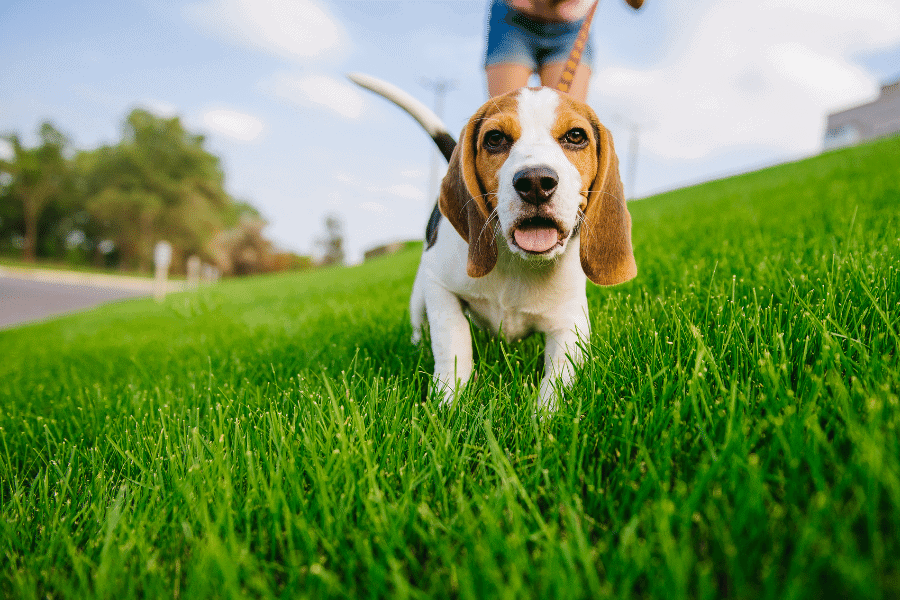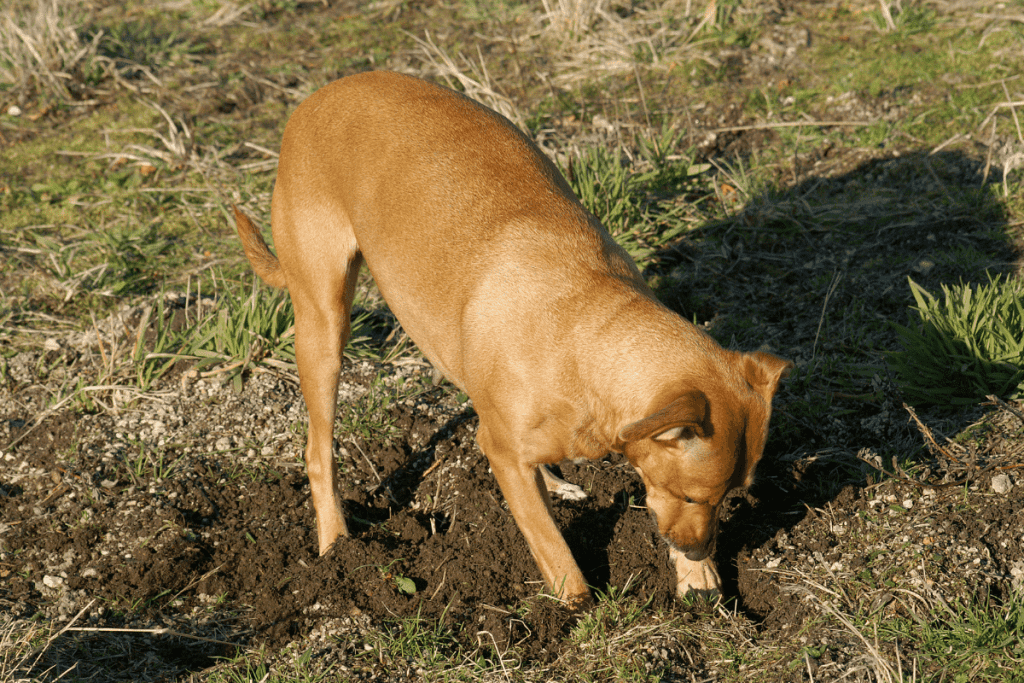Dogs may be considered “man’s best friend,” but they are also your lawn’s worst enemy.
Your beloved pooch can wreak havoc on your yard in several ways.
Running, playing, digging, and even bathroom breaks can kill grass and create an unsightly lawn.
We’ve compiled a list of some of the best types of grass to satisfy your pup and your home owner’s association.

Table of Contents
Kentucky Bluegrass
Kentucky Bluegrass in a nutshell:
- Cool-season grass
- Suitable in USDA zones 2-6
- Pros: Best for extremely cold temperatures
- Cons: High maintenance
Don’t let the name fool you.
Kentucky Bluegrass isn’t only for residents of the southern state.
Surprisingly, it’s one of the best-suited grasses for cold weather and can withstand harsh winters.
Found in many parts of the U.S., this lush, green perennial grass will grow into a dense and durable lawn when given the right climate and conditions.
Although it has a relatively shallow root system, Kentucky Bluegrass is great for heavy traffic.
This tough variety is known for its self-repair and is often found on athletic fields, making it an excellent option for dog owners.
While Kentucky Bluegrass is known for its durability, it doesn’t fare well in high heat and drought conditions.
Because of its dense formation, Kentucky Bluegrass isn’t as resistant to urine as other grasses, so keep this in mind if your pooch has a favorite spot for bathroom breaks and use the tip mentioned above to dilute urine.
Perennial Ryegrass
Perennial Ryegrass in a nutshell:
- Cool-season grass
- Suitable in USDA zones 3-7
- Pros: Best cool-season grass for quick germination and recovery
- Cons: High maintenance
Another excellent option for pet parents is Perennial Ryegrass.
This plush, fine-bladed turf grass is one of the most popular lawn grasses in the Pacific Northwest.
Perennial Ryegrass has an excellent ability to withstand cold temperatures but isn’t as cold-hardy as Kentucky Bluegrass.
Like most cool-season grasses, Perennial Ryegrass doesn’t have a great tolerance for heat and drought conditions.
Considered a “high quality” pasture grass for livestock, it’s sure to withstand the wear and tear from your rambunctious pup.
Perennial Ryegrass is also known for its ability to germinate quickly, so it’s a great contender if your lawn needs a quick color boost.
Tall Fescue
Tall Fescue in a nutshell:
- Cool-season grass
- Suitable in USDA zones 4-7
- Pros: Best cool-season grass for transition regions; Easy to maintain; Disease resistant
- Cons: Slow growth rate
Tall Fescue is one of the most durable cool-season grasses and is an excellent lawn grass for transition regions.
Although Tall Fescue is a cool-season grass, it can withstand heat and drought, unlike Kentucky Bluegrass or Perennial Ryegrass.
Additionally, its disease resistant and shade tolerant.
Tall Fescue boasts a deep root system and results in a resilient and dense turf, so your dog can romp around freely without damaging the lawn.
In addition to its durability, Tall Fescue requires little upkeep and requires less watering and trimming compared to other species of lawn grasses.
However, Tall Fescue has a slow growth rate and doesn’t handle damage well because of the deep root system.
Zoysia
Zoysia in a nutshell:
- Warm-season grass
- Suitable in USDA zones 5-11
- Pros: Best warm-season grass for transition regions; Great for high traffic areas and large, rambunctious dogs.
- Cons: Slow Growth Rate
Similar to Tall Fescue, Zoysia Grass is frequently found in transition regions.
This warm-season grass is tolerant of heat and drought but is more cold-hardy than other warm-season grasses.
Zoysia Grass grows in extremely dense clusters, which creates a solid foundation that can sustain wear-and-tear from playful puppies to large, active dogs.
Zoysia grows by stems above and underground, which results in a thick, carpetlike lawn – one of the most notable features of Zoysia grass.
The grass is so dense weeds rarely penetrate Zoysia.
Additionally, the grass can retain and reserve water better than other lawn grasses.
Because Zoysia is so dense, the vegetation will retain urine like a sponge and can cause patches to burn, so be sure to dilute your dog’s urine and employ other tricks to avoid repeated urination in one spot.
However, Zoysia Grass grows very slowly and will take longer to self-repair when damaged.
However, our post on reviving dying Zoysia grass will help you keep the grass healthy even with dogs around.
Bermuda Grass
Bermuda grass in a nutshell:
- Warm-season grass
- Suitable in USDA zones 7-10
- Pros: One of the most drought-tolerant grass options; Fastest growth rate among warm-season grasses
- Cons: Cold intolerant
If you live in an area with intense heat and sun, Bermuda Grass is an excellent option for you and your playful pup.
This hardy grass is also resistant to pests and salt and is frequently found in warm coastal climates.
In addition to heat tolerance, this resilient grass is known to recover from foot traffic and other damage quickly, making it an excellent option to stand up to your dog’s zoomies and games of fetch.
Similar to Zoysia, Bermuda Grass boasts an intricate root system with stems above and below ground.
However, unlike Zoysia, Bermuda Grass has a rapid growth rate and can self-repair easily.
Because of the rapid growth rate and resilient root system, Bermuda Grass can withstand harsh environments and is often found on athletic fields and golf courses in hot southern regions.
Centipede Grass
Centipede grass in a nutshell:
- Warm-season grass
- Suitable in USDA zones 7-10
- Pros: Best for lawns in the Southeast; Will remain green year-round in the right soil conditions and climate
- Cons: Shallow root system
Centipede Grass will create a lovely green lawn you and your pup can enjoy year-round when planted in the right environment.
It thrives in sandy, acidic soil and is often found in coastal regions of the Southeast where winters are mild, and rain is plentiful.
Centipede Grass is very low maintenance.
However, it isn’t as resilient as the other warm-season grasses and won’t survive harsh winters or drought.
Unlike the other warm-season grasses, Centipede Grass doesn’t have a dormancy period in the winter.
Because of this, Centipede Grass is extremely cold intolerant but will stay green in the winter months when planted in the right environment.
Warning: Centipede Grass has a shallow root system and is slow to self-repair, so it won’t stand up to heavy foot traffic and may not be a great option for pet parents with large, energetic dogs.
Artificial Grass
Artifical grasses in a nutshell:
- Suitable in all USDA zones
- Pros: Low maintenance; Comes in many varieties; Year-round green grass.
- Cons: Initial investment cost; Requires regular cleaning.
Frequently found on sports fields and at dog parks, artificial grass is a popular choice for pet owners for many reasons.
Synthetic turf is much more durable than natural grasses, requires minimal upkeep, and can withstand extreme weather conditions.
Artificial grasses come in many different varieties to suit your specific needs, taste, and budget.
Many brands even have a specific “pet turf,” which allows for more drainage to ease the burden of cleaning.
Although turf requires less upkeep than natural lawn grasses, pet parents will need to ensure they’re properly cleaning and disposing of pet waste to keep the artificial grass from becoming stinky.
Check out this article for detailed instructions on how to clean artificial grass.
Artificial grass comes with a hefty price tag initially, but you’ll likely save money on landscaping costs such as fertilizer, lawn tools, and labor in the long run.
Interested in learning more about artificial grass?
We compiled additional info about the pros and cons of artificial grass in our article on how long artificial grass lasts.
Some homeowners associations only allow natural grasses, so be sure to check with your neighborhood or subdivision if necessary.
Lawn Damage Caused By Dogs

Peeing & Pooping
Dog urine contains an ingredient called urea, which is extremely high in nitrogen.
While nitrogen is beneficial for lawns and supports vegetation growth, the excessive concentration of nitrogen in dog urea can kill areas of your lawn and cause brown patches.
(Especially if your pooch has a favorite potty spot.)
The nitrogen in dog feces is less likely to damage your lawn than dog urine, but it does contain some nitrogen.
However, it’s likely bacteria and fungi will grow if you don’t clean up your dog’s waste regularly and also create a biohazard.
Pro tip: Encourage or direct your dog to go to the bathroom on different areas of the lawn by taking them out on leashed bathroom breaks.
This will keep your dog from repeatedly urinating and defecting in the same spot and decrease the likelihood of burn spots and bare patches.
Bring a water canister and dilute the urine by pouring water over the area.
Running and Playing
It’s no surprise a playful pup can cause wear-and-tear to your green grass.
Rather than discouraging playtime in the yard, employ basic training and some expert tricks to keep your dog from digging and creating bare patches.
Below you’ll find some tips and tricks to satisfy your playful pooch while maintaining a luscious lawn.
- Let your dog have the full range of the lawn rather than keeping them attached to a rope or caged in a specific section of your yard.
- Encourage your dog to play in different areas of the yard. Throw the ball or toy in different directions and areas during games of fetch.
- Move lawn furniture, toys, and other barriers. This will eliminate traffic patterns wearing down the grass, causing exposed ground or soil.
- Don’t let your dog play on wet grass.
- Take your dog on walks around the neighborhood or to a local park.
Grass Traits To Consider: Climate & Durability
Climate and USDA Zones
Climate is one of the most important factors when choosing a grass type for your yard.
If you choose the wrong type of grass for your environment, you’ll likely end up with a lonely lawn and a dirty dog.
It’s important to consider the local soil conditions, rainfall, temperature, and amount of sun or shade when choosing the best grass for you and your furry friend.
A quick and easy way to identify the best grass for your climate is to use the USDA Plant Hardiness Map to identify which zone you live in and what plants and vegetation will flourish in your area.
The USDA zones range from 1-13 and generally run from north to south.
The scale starts at the coldest regions and progresses into warmer climates.
Durability and Resilience
While many factors influence a grass’s ability to stand up to foot traffic and other disturbances, an intricate root system is one of the most important things to consider.
A deep root system intricately fuses the grass and soil, making it more difficult for your pup to tear or damage the grass when running and playing.
You should also keep in mind its growth rate which influences the grass’s ability to self-repair.
Fast-growing grasses will cover lawn blemishes before they appear, whereas slow-growing grasses will take longer to heal damaged areas.
However, most grasses with a deep root system have a slower growth rate, so it’s important to evaluate your climate and needs before ruling out a grass deemed slow-growing or shallow.
Check out our post on how deep are grass roots for additional information and FAQ.